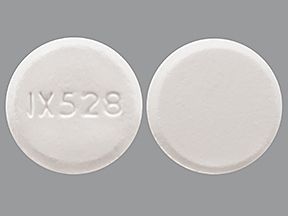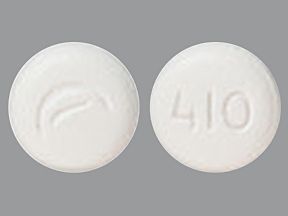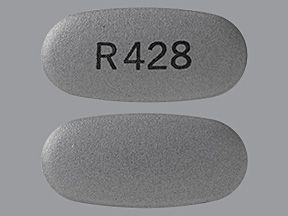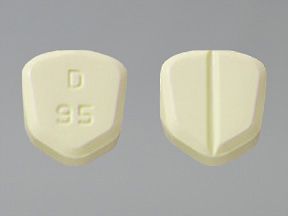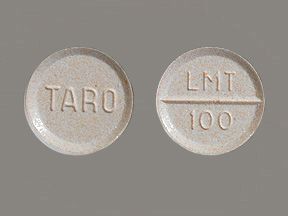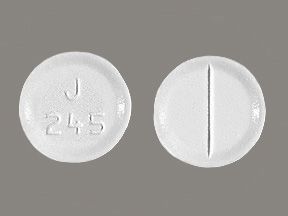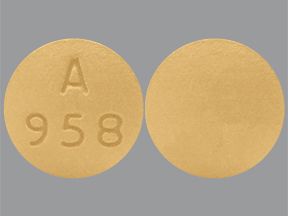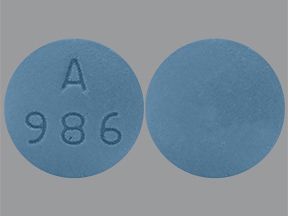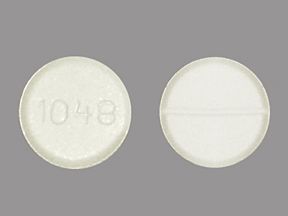Lamotrigine is a generic prescription drug. It’s FDA-approved to treat the following conditions:
- Epilepsy. Lamotrigine is used to treat specific seizure types that occur in certain adults and children with epilepsy. The drug can be prescribed alone or in combination with other epilepsy drugs.
- Bipolar disorder. Lamotrigine is used for the long-term treatment of bipolar I disorder in adults. The drug is typically prescribed in combination with other bipolar disorder drugs.
Lamotrigine has limitations of use. For details about this and the conditions above, see the “Lamotrigine oral tablets uses” section below.
Drug details
Lamotrigine belongs to a class of drugs called antiepileptics. It’s available in the following forms and strengths:
- oral tablet, which comes in:
- 25 milligrams (mg)
- 100 mg
- 150 mg
- 200 mg
- extended-release* oral tablet, which comes in:
- 25 mg
- 50 mg
- 100 mg
- 200 mg
- chewable tablet, which comes in 5 mg and 25 mg
- orally disintegrating tablet, which comes in:
- 25 mg
- 50 mg
- 100 mg
- 200 mg
* Extended release means that the tablet slowly releases its active ingredient into your body over time.
Brand-name versions
Lamotrigine is a generic drug. It’s also available in the following brand-name versions:
- Lamictal, which comes as an oral tablet
- Lamictal XR, which comes as an extended-release oral tablet
- Lamictal CD, which comes as a chewable tablet
- Lamictal ODT, which comes as an orally disintegrating tablet
For information on the brand-name versions above, talk with your doctor or pharmacist.
Lamotrigine is a generic drug. A generic drug is an exact copy of the active drug in a brand-name medication. Below are the brand-name medications that lamotrigine is based on:
- lamotrigine oral tablet is based on Lamictal
- lamotrigine extended-release oral tablet is based on Lamictal XR
- lamotrigine chewable tablet is based on Lamictal CD
- lamotrigine orally disintegrating tablet is based on Lamictal ODT
A generic is considered to be as safe and effective as the original drug. Generics tend to cost less than brand-name drugs.
If you’re interested in using Lamictal, Lamictal XR, Lamictal CD, or Lamictal ODT instead of lamotrigine, talk with your doctor. They can tell you whether the brand-name versions come in forms and strengths that you can take for your condition. If you have insurance, you’ll also need to check whether your plan will cover any brand-name forms of lamotrigine.
To learn more about how generics compare with brand-name drugs, see this article.
Lamotrigine can cause mild or serious side effects (also known as adverse effects). These side effects may differ slightly between people with epilepsy and people with bipolar disorder.
The following lists contain some of the key side effects that may occur while taking lamotrigine. These lists do not include all possible side effects.
For more information about the possible side effects of lamotrigine, talk with your doctor or pharmacist. They can give you tips on how to manage any side effects that may be concerning or bothersome.
Note: The Food and Drug Administration (FDA) tracks side effects of drugs it has approved. If you’d like to notify the FDA about a side effect you’ve had with lamotrigine, you can do so through MedWatch.
Mild side effects
Below is a partial list of mild side effects of lamotrigine. To learn about other mild side effects, talk with your doctor or pharmacist. You can also view the prescribing information for the drug’s oral tablets, extended-release tablets, chewable tablets, and orally disintegrating tablets.
Mild side effects of lamotrigine can include:
- abdominal pain
- accidental injury
- back pain
- diarrhea
- dizziness
- dry mouth
- fatigue
- fever
- headache
- infection, such as urinary tract infection (UTI) or the flu
- lack of muscle coordination
- nausea and vomiting
- inflammation inside the nose
- sleep problems, such as sleepiness or insomnia
- sore throat
- tremors, which may occur with targeted movements such as touching your nose
- vision problems, such as blurred vision or double vision
- mild allergic reaction*
Most of these side effects may go away within a few days to a couple of weeks. However, if they become more severe or don’t go away, talk with your doctor or pharmacist.
* For more information about allergic reaction and lamotrigine, see “Allergic reaction” below.
Serious side effects
Serious side effects from lamotrigine aren’t common, but they can occur. Call your doctor right away if you have serious side effects. Call 911 or your local emergency number if your symptoms feel life threatening or if you think you’re having a medical emergency.
Serious side effects can include:
- abnormal heart rhythm
- aseptic meningitis (inflammation of the brain and spinal cord)
- hemophagocytic lymphohistiocytosis, which is a life threatening immune system reaction
- low levels of certain blood cells, including white blood cells, red blood cells, and platelets
- suicidal thoughts or behaviors
- withdrawal seizures (more severe or frequent seizures) if lamotrigine is suddenly stopped
- risk of serious skin rash*
- severe allergic reaction†
* Lamotrigine oral tablets, extended-release tablets, chewable tablets, and orally disintegrating tablets have a
† For details about allergic reaction and lamotrigine, see “Allergic reaction” below.
Side effects in children
Lamotrigine is approved to treat specific types of seizures that occur in certain children with epilepsy. (To learn more, see the “Lamotrigine oral tablets uses” section below.)
Side effects of lamotrigine in children are expected to be the same as those in adults. For lists of these side effects, see “Mild side effects” and “Serious side effects” above.
Lamotrigine has a
To learn more about your child’s risk of side effects with lamotrigine, talk with their doctor.
ALLERGIC REACTIONAs with most drugs, some people can have an allergic reaction after taking lamotrigine. This was a rare side effect in clinical trials of lamotrigine oral tablets, extended-release tablets, chewable tablets, and orally disintegrating tablets.
Symptoms of a mild allergic reaction can include:
A more severe allergic reaction is rare but possible. Symptoms of a severe allergic reaction can include:
- swelling under your skin, typically in your eyelids, lips, hands, or feet
- swelling of your tongue, mouth, or throat
- trouble breathing
Call your doctor right away if you have an allergic reaction to lamotrigine, as the reaction could become severe. Call 911 or your local emergency number if your symptoms feel life threatening or if you think you’re having a medical emergency.
Here are answers to some frequently asked questions about lamotrigine.
How do side effects of lamotrigine 25-mg tablets compare with 100-mg or 200-mg tablets?
The manufacturer of lamotrigine didn’t provide side effects specific to each strength the drug comes in. The side effects of lamotrigine are likely the same regardless of the strength you take.
Lamotrigine is available in the following forms and strengths:
- oral tablet, which comes in:
- 25 milligrams (mg)
- 100 mg
- 150 mg
- 200 mg
- extended-release* oral tablet, which comes in:
- 25 mg
- 50 mg
- 100 mg
- 200 mg
- chewable tablet, which comes in 5 mg and 25 mg
- orally disintegrating tablet, which comes in:
- 25 mg
- 50 mg
- 100 mg
- 200 mg
For lists of possible side effects of this drug, see the “Lamotrigine oral tablets side effects” section above. You can also view the prescribing information for lamotrigine oral tablets, extended-release tablets, chewable tablets, and orally disintegrating tablets.
To learn more about what to expect with the strength of lamotrigine you’re prescribed, talk with your doctor or pharmacist.
Can lamotrigine be used for depression or anxiety?
Lamotrigine is not approved to treat depression or anxiety. However, doctors may prescribe it off-label for these conditions. Off-label drug use is when a drug is prescribed for a purpose other than what it’s approved for.
Lamotrigine is only approved to treat epilepsy and bipolar disorder in certain people. It belongs to a class of drugs called antiepileptics. When used for bipolar disorder, lamotrigine is sometimes called a mood stabilizer.
To learn more about lamotrigine’s use for depression and anxiety, talk with your doctor.
Does lamotrigine cause weight gain?
It’s possible that lamotrigine may cause weight gain. However, this side effect was rare in clinical trials of lamotrigine oral tablets, extended-release tablets, chewable tablets, and orally disintegrating tablets.
If you’re concerned about weight gain with lamotrigine, talk with your doctor. They can suggest ways for you to maintain a weight that’s healthy for you.
What is lamotrigine’s half-life?
The half-life of lamotrigine is about 25 hours. A drug’s half-life is the time it takes your body to get rid of half of a drug’s dose. For lamotrigine, this means it takes about 25 hours for your body to get rid of half a dose.
It usually takes about five half-lives for a drug to leave your system completely. So, lamotrigine stays in your system for about 125 hours, which is about 5 days.
If you have questions about this, talk with your doctor or pharmacist.
Is lamotrigine a controlled substance?
No, lamotrigine is not a controlled substance.
A controlled substance is a medication that has the potential to be misused or cause dependence. (With misuse, a drug is taken differently from how it was prescribed. With dependence, your body needs a drug to function as you usually do.)
Due to these risks, controlled substances are regulated by the federal government. Doctors must follow specific rules when prescribing them. And pharmacists must follow certain rules when dispensing them. However, these risks and rules do not apply to lamotrigine.
The lamotrigine dosage your doctor prescribes will depend on several factors. These include:
- the type and severity of the condition you’re using Lamotrigine to treat
- your age
- the form of lamotrigine you take
- other medical conditions you may have
- other medications you’re taking
- body weight (in children)
Typically, your doctor will start you on a low dosage. They’ll do this to reduce your risk of a serious skin rash* with lamotrigine. Then your doctor will adjust your dosage over time to reach the amount that’s right for you. They’ll ultimately prescribe the smallest dosage that provides the desired effect.
The following information describes dosages that are commonly used or recommended. However, be sure to take the dosage your doctor prescribes for you. Your doctor will determine the best dosage to fit your needs.
* Lamotrigine oral tablets, extended-release tablets, chewable tablets, and orally disintegrating tablets have a
Lamotrigine oral tablet forms and strengths
Lamotrigine is available in the following forms and strengths:
- oral tablet, which comes in:
- 25 milligrams (mg)
- 100 mg
- 150 mg
- 200 mg
- extended-release (ER)* oral tablet, which comes in:
- 25 mg
- 50 mg
- 100 mg
- 200 mg
- chewable tablet, which comes in 5 mg and 25 mg
- orally disintegrating tablet (ODT), which comes in:
- 25 mg
- 50 mg
- 100 mg
- 200 mg
The form of lamotrigine you’ll take depends on certain factors. These include whether you’re able to swallow whole tablets and the condition being treated. For example, lamotrigine extended-release oral tablets are not approved to treat bipolar disorder. Your doctor is not likely to prescribe this form of lamotrigine for this use.
Your doctor can recommend the form of lamotrigine that may be best for your specific situation.
* ER means that the tablet slowly releases its active ingredient into your body over time.
Lamotrigine dosage for epilepsy
For epilepsy, lamotrigine can be prescribed alone or in combination with other epilepsy drugs. (For details, see the “Lamotrigine oral tablets uses” section below.)
The recommended dosages of lamotrigine for epilepsy can vary depending on the form used, as described below.
Lamotrigine oral tablets, chewable tablets, and ODT for epilepsy
When used alone, the usual dosage of lamotrigine oral tablets, chewable tablets, and ODT is 500 mg per day. This is typically divided into two doses. Your doctor will tell you when and how often to take your dose.
When used with other epilepsy drugs, the usual dosage of these forms of lamotrigine depends on the specific drug combination you’re prescribed. The table below includes the following dosing options for epilepsy:
- Option 1: If you take lamotrigine with valproate or similar drugs, including:
- valproic acid
- divalproex sodium (Depakote, Depakote ER).
- Option 2: If you take lamotrigine with epilepsy drugs other than the following:
- Valproate or similar drugs, including:
- valproic acid
- divalproex sodium (Depakote, Depakote ER)
- carbamazepine (Carbatrol, Epitol, others)
- phenytoin (Dilantin, Phenytek)
- phenobarbital (Sezaby)
- primidone (Mysoline)
- Valproate or similar drugs, including:
- Option 3: If you take lamotrigine without valproate (or its similar drugs listed above) but with any of the following:
- carbamazepine (Carbatrol, Epitol, others)
- phenytoin (Dilantin, Phenytek)
- phenobarbital (Sezaby)
- primidone (Mysoline)
| Option 1 | Option 2 | Option 3 | |
| Dose | 100 mg to 400 mg* | 225 mg to 375 mg | 300 mg to 500 mg |
| How often | once per day, or divided into 2 doses per day | divided into 2 doses per day | divided into 2 doses per day |
| Administered by | self | self | self |
* This dose is typically limited to 200 mg per day. But a dose of up to 400 mg per day may be used if you take lamotrigine with valproate and certain other medications that interact with lamotrigine. See the “Lamotrigine oral tablets precautions” section below to learn more about interactions with lamotrigine.
Lamotrigine ER oral tablets for epilepsy
When used alone, the usual dosage of lamotrigine ER oral tablets is 250 mg to 300 mg once per day.
When used with other epilepsy drugs, the usual dosage of lamotrigine ER oral tablets depends on the specific drug combination you’re prescribed. The table below includes the following dosing options for epilepsy:
- Option 1: If you take lamotrigine ER oral tablets with valproate or similar drugs, including:
- valproic acid
- divalproex sodium (Depakote, Depakote ER)
- Option 2: If you take lamotrigine ER oral tablets with epilepsy drugs other than the following:
- valproate or similar drugs, including:
- valproic acid
- divalproex sodium (Depakote, Depakote ER)
- carbamazepine (Carbatrol, Epitol, others)
- phenytoin (Dilantin, Phenytek)
- phenobarbital (Sezaby)
- primidone (Mysoline)
- valproate or similar drugs, including:
- Option 3: If you take lamotrigine ER oral tablets without valproate (or its similar drugs listed above) but with any of the following:
- carbamazepine (Carbatrol, Epitol, others)
- phenytoin (Dilantin, Phenytek)
- phenobarbital (Sezaby)
- primidone (Mysoline)
| Option 1 | Option 2 | Option 3 | |
| Dose | 200 mg to 250 mg | 300 mg to 400 mg | 400 mg to 600 mg |
| How often | once per day | once per day | once per day |
| Administered by | self | self | self |
Lamotrigine dosage for bipolar disorder
For bipolar disorder, doctors will likely prescribe lamotrigine oral tablets, chewable tablets, or ODT. Lamotrigine ER oral tablets are not approved to treat bipolar disorder.
For this use, lamotrigine is typically prescribed in combination with other bipolar disorder drugs. (For details, see the “Lamotrigine oral tablets uses” section below.)
Keep in mind that certain epilepsy drugs can also treat bipolar disorder. When used for this condition, epilepsy drugs are sometimes called mood stabilizers.
The usual dosage of lamotrigine depends on the specific drug combination you’re prescribed. The table below includes the following dosing options for bipolar disorder:
- Option 1: If you take lamotrigine with valproate or similar drugs, including:
- valproic acid
- divalproex sodium (Depakote, Depakote ER)
- Option 2: If you take lamotrigine alone or with a mood stabilizer other than the following:
- valproate or similar drugs, including:
- valproic acid
- divalproex sodium (Depakote, Depakote ER)
- carbamazepine (Carbatrol, Epitol, others)
- phenytoin (Dilantin, Phenytek)
- phenobarbital (Sezaby)
- primidone (Mysoline)
- valproate or similar drugs, including:
- Option 3: If you take lamotrigine without valproate (or its similar drugs listed above) but with any of the following:
- carbamazepine (Carbatrol, Epitol, others)
- phenytoin (Dilantin, Phenytek)
- phenobarbital (Sezaby)
- primidone (Mysoline)
| Option 1 | Option 2 | Option 3 | |
| Dose | 100 mg | 200 mg | up to 400 mg |
| How often | once per day | once per day | divided into 2 doses per day |
| Administered by | self | self | self |
Children’s dosage
Lamotrigine is approved to treat specific types of seizures that occur with epilepsy in children. For this use, lamotrigine can be prescribed alone or in combination with other epilepsy drugs. (For details, see the “Lamotrigine oral tablets uses” section below.)
The recommended dosages of lamotrigine for epilepsy in children can vary depending on the child’s age and the form of the prescribed drug, as described below.
Lamotrigine oral tablets, chewable tablets, and ODT for epilepsy in children
Lamotrigine oral tablets, chewable tablets, and orally disintegrating tablets can be used alone to treat epilepsy in children ages 16 years and older. For this use, the usual dosage of lamotrigine is the same for children and adults. For details, see “Lamotrigine dosage for epilepsy” above.
These forms of lamotrigine can also be prescribed in combination with other epilepsy drugs in children ages 2 years and older. For children ages 13 years and older, the lamotrigine dosage is the same as for adults. For details, see “Lamotrigine dosage for epilepsy” above.
For children ages 2 to 12 years, the usual dosage of lamotrigine depends on the specific drug combination the child is prescribed. The child’s dosage is based on milligrams (mg) of lamotrigine per kilogram (kg) of body weight. One kg is about 2.2 pounds (lb).
The table below includes the following dosing options for epilepsy in children ages 2 to 12 years:
- Option 1: If your child takes lamotrigine with valproate or similar drugs, including:
- valproic acid
- divalproex sodium (Depakote, Depakote ER)
- Option 2: If your child takes lamotrigine with epilepsy drugs other than the following:
- valproate or similar drugs, including:
- valproic acid
- divalproex sodium (Depakote, Depakote ER)
- carbamazepine (Carbatrol, Epitol, others)
- phenytoin (Dilantin, Phenytek)
- phenobarbital (Sezaby)
- primidone (Mysoline)
- valproate or similar drugs, including:
- Option 3: If your child takes lamotrigine without valproate (or its similar drugs listed above) but with any of the following:
- carbamazepine (Carbatrol, Epitol, others)
- phenytoin (Dilantin, Phenytek)
- phenobarbital (Sezaby)
- primidone (Mysoline)
| Option 1 | Option 2 | Option 3 | |
| Dose | 1 mg/kg to 5 mg/kg* | 4.5 mg/kg to 7.5 mg/kg | 5 mg/kg to 15 mg/kg |
| How often | once per day, or divided into 2 doses per day | divided into 2 doses per day | divided into 2 doses per day |
| Administered by | self or caregiver | self or caregiver | self or caregiver |
* As an example, a child weighing 25 kg (about 55 lb) would be prescribed between 25 mg and 125 mg. This dose would either be given once per day or divided into 2 doses per day.
Lamotrigine ER oral tablets for epilepsy in children
Lamotrigine extended-release (ER) tablets can be used alone or with other epilepsy drugs for certain seizures in children ages 13 years and older.
For this purpose, the child dosage of lamotrigine ER tablets is the same as for adults. For details, see “Lamotrigine dosage for epilepsy” above.
What if I miss a dose?
If you miss a dose of lamotrigine, take it as soon as you remember. But if it’s almost time for your next dose, just skip your missed dose. Then take your next dose at its usual time.
Do not take any extra doses of lamotrigine to make up for a missed dose. Doing so can increase your risk of side effects from the drug.
To help make sure that you don’t miss a dose, try using a medication reminder. This can include setting an alarm or using a timer. You could also download a reminder app on your phone.
Will I need to use this drug long term?
Doctors may prescribe lamotrigine as a long-term treatment. If you and your doctor determine that lamotrigine is safe and effective for you, you’ll likely take it long term.
The Food and Drug Administration (FDA) approves prescription drugs such as lamotrigine to treat certain conditions. Lamotrigine may also be prescribed off-label for other conditions. Off-label drug use is when an FDA-approved drug is prescribed for a purpose other than what it’s approved for.
Lamotrigine for epilepsy
The FDA has approved lamotrigine to treat specific types of seizures that occur with epilepsy. For this use, the drug can be prescribed alone or in combination with other epilepsy drugs as described below.
Lamotrigine used alone for epilepsy
Lamotrigine can be used alone to treat focal onset seizures (previously known as partial-onset seizures). The drug is prescribed for people who are switching to lamotrigine from one of the following epilepsy drugs:
- valproate or similar drugs, including:
- valproic acid
- divalproex sodium (Depakote, Depakote ER)
- carbamazepine (Carbatrol, Epitol, others)
- phenytoin (Dilantin, Phenytek)
- phenobarbital (Sezaby)
- primidone (Mysoline)
Lamotrigine oral tablets, chewable tablets, and orally disintegrating tablets can be used for this purpose in adults and children ages 16 years and older. Lamotrigine extended-release tablets can be used for this purpose in adults and children ages 13 years and older.
Lamotrigine used with other epilepsy drugs
Lamotrigine can be used with other epilepsy drugs to treat:
- focal onset seizures
- primary generalized tonic-clonic seizures (previously known as grand mal seizures)
- seizures that occur with Lennox-Gastaut syndrome (a type of severe epilepsy)
Lamotrigine oral tablets, chewable tablets, and orally disintegrating tablets can be used for this purpose in adults and children ages 2 years and older.
Lamotrigine extended-release (ER) tablets can be used to treat focal onset seizures and primary generalized tonic-clonic seizures in adults and children ages 13 years and older.
Note:Lamotrigine ER tablets have a limitation of use. The manufacturer warns against prescribing the drug for children younger than age 13 years. It’s not known whether lamotrigine ER tablets are safe or effective to treat children younger than this age.
Epilepsy explained
Epilepsy is a condition that causes periodic seizures. These may occur because of unusual electrical activity in the brain.
Symptoms of epilepsy vary depending on the specific seizure type but can include:
- loss of consciousness
- muscle stiffness
- jerking body movements
- unusual movements of the eyes, mouth, or head
You can learn more about epilepsy by visiting our epilepsy hub.
Lamotrigine for bipolar disorder
The FDA has approved lamotrigine oral tablets, chewable tablets, and orally disintegrating tablets to treat bipolar I disorder in adults. Lamotrigine ER oral tablets are not approved to treat this condition.
Lamotrigine is used as a long-term treatment for bipolar I disorder. The drug can be prescribed to help increase the time between mood episodes that occur with this condition.
For this purpose, lamotrigine is typically prescribed in combination with other bipolar disorder drugs. Examples include epilepsy drugs used as mood stabilizers, such as carbamazepine (Carbatrol, Epitol, others).
Note:Lamotrigine has a limitation of use. The manufacturer warns against prescribing the drug for the treatment of manic or mixed episodes in bipolar disorder. The drug hasn’t been shown to be effective for these conditions.
Bipolar disorder explained
Bipolar I disorder is a mood disorder that typically involves specific mood episodes. These include manic episodes, depressive episodes, and mixed episodes.
With manic episodes, you have moments of extremely high energy and excitement that affect your daily life. With depressive episodes, you have periods of hopelessness, fatigue, and a loss of interest in activities you used to enjoy. With mixed episodes, you have symptoms of both manic and depressive episodes at the same time.
You can learn more about bipolar disorder by visiting our bipolar disorder hub.
Lamotrigine and children
Lamotrigine is approved to treat specific seizure types that occur with epilepsy in children.
Doctors can prescribe lamotrigine oral tablets, chewable tablets, and orally disintegrating tablets for this purpose in children ages 2 years and older. Lamotrigine extended-release tablets can be used for this purpose in children ages 13 years and older.
To learn more, see the “Lamotrigine for epilepsy” section above.
This drug comes with several precautions. These are considered drug-condition interactions.
FDA warning: Risk of serious skin rash
This drug has a
Risk of serious skin rash. Taking lamotrigine may cause a serious skin rash. However, this side effect was rare in clinical trials of lamotrigine oral tablets, extended-release tablets, chewable tablets, and orally disintegrating tablets. In some cases, skin rash with lamotrigine can be fatal.
The risk of skin rash may be higher in children* than in adults. Your risk may also be high if:
- you take a higher dosage of lamotrigine than what is recommended
- your lamotrigine dosage is increased faster than what is recommended
- you take lamotrigine with an epilepsy drug called valproate or similar drugs, including:
- valproic acid
- divalproex sodium (Depakote, Depakote ER)
Skin rash with lamotrigine can happen at any time during treatment. However, it’s more likely to occur in the first 2 to 8 weeks of treatment.
While you’re taking lamotrigine, watch for symptoms of serious skin rash. Examples include peeling skin, blisters, and fever. If you have these symptoms, your doctor will likely have you stop taking the drug. They’ll advise you on what treatments are needed for serious skin rash.
* Lamotrigine is approved for specific uses in children. For details, see the “Lamotrigine oral tablets uses” section above.
Other precautions
In addition to the boxed warnings mentioned above, lamotrigine has other warnings.
If any of the following medical conditions or other health factors pertain to you, be sure to talk with your doctor before taking lamotrigine:
- if you’re pregnant or thinking about becoming pregnant
- if you’re breastfeeding or thinking about breastfeeding
- if you’ve had an allergic reaction to either drug or any of its ingredients
- if you have heart problems, such as heart failure or abnormal heart rhythm
- if you have or have had depression or other mood problems, including suicidal thoughts and behaviors
- if you have a liver or kidney problem, such as liver failure or kidney failure
Note: For more information about the potential negative effects of lamotrigine, see the “Lamotrigine oral tablets side effects” section above.
Suicide prevention
If you know someone at immediate risk of self-harm, suicide, or hurting another person:
- Ask the tough question: “Are you considering suicide?”
- Listen to the person without judgment.
- Call 911 or the local emergency number, or text TALK to 741741 to communicate with a trained crisis counselor.
- Stay with the person until professional help arrives.
- Try to remove any weapons, medications, or other potentially harmful objects.
If you or someone you know is having thoughts of suicide, a prevention hotline can help. The 988 Suicide and Crisis Lifeline is available 24 hours a day at 988. During a crisis, people who are hard of hearing can use their preferred relay service or dial 711 then 988.
Lamotrigine can interact with several other medications. It’s not known to interact with supplements or foods.
Different interactions can cause different effects. For instance, some interactions can interfere with how well a drug works. Other interactions can increase side effects or make them more severe. Drug-condition interactions can also cause certain effects. For information about these interactions, see the “Lamotrigine oral tablets precautions” section above.
Lamotrigine and other medications
Before taking lamotrigine, talk with your doctor and pharmacist. Tell them about all prescription, over-the-counter, and other drugs you take. Also tell them about any vitamins, herbs, and supplements you use. Sharing this information can help you avoid potential interactions.
Below is a table of medications that can interact with lamotrigine. This table does not contain all drugs that may interact with lamotrigine.
| Medication type or medication name | Medication examples |
| certain epilepsy drugs | • valproate and similar drugs, including valproic acid and divalproex sodium (Depakote, Depakote ER) • carbamazepine (Carbatrol, Epitol, others) • phenytoin (Dilantin, Phenytek) • phenobarbital (Sezaby) • primidone (Mysoline) |
| certain antiretroviral drugs | • ritonavir (Norvir) • products that contain lopinavir, such as lopinavir/ritonavir (Kaletra) • atazanavir (Reyataz) |
| certain birth control pills | • ethinyl estradiol/levonorgestrel (Seasonale, Seasonique, others) |
| rifampin (Rifadin, Rimactane) | — |
Your doctor or pharmacist can provide you with more information about the interactions between these medications and lamotrigine. If you have questions about any drug interactions that may affect you, your doctor or pharmacist can also address those.
Other interactions
Other types of interactions, such as those with herbs, supplements, foods, lab tests, and vaccines, may also occur with the use of lamotrigine. The following table lists some of these interactions.
| Cause of interaction | Examples |
| lab tests | urine drug tests for phencyclidine (PCP) |
Your doctor can provide you with details about these interactions with lamotrigine.
There’s no known interaction between lamotrigine and alcohol.
However, in rare cases, drinking alcohol while taking lamotrigine could lead to alcohol intolerance. With this condition, your body’s digestive system cannot break down alcohol as it usually would. This could lead to digestive symptoms, such as nausea, vomiting, and diarrhea. Other symptoms of alcohol intolerance include facial discoloration, stuffy or runny nose, and hives.
If you drink alcohol, talk with your doctor before taking lamotrigine. They can recommend whether you should limit the amount of alcohol you consume.
Here is important information about lamotrigine, pregnancy, and breastfeeding.
Lamotrigine and pregnancy
It’s not known whether lamotrigine is safe to take while pregnant. Studies* of the drug’s use in pregnancy since lamotrigine was approved for use have not shown any harm to a pregnant person or fetus.
However, based on animal studies, lamotrigine may cause harm if used in pregnancy. This is because offspring born to pregnant animals receiving the drug developed low body weight and bone problems. Keep in mind that animal studies do not always predict what happens with humans.
Tell your doctor right away if you become pregnant while taking lamotrigine. They can advise on the risks and benefits of continuing treatment with this medication.
* For more details about lamotrigine and pregnancy, see the prescribing information for the drug’s oral tablets, extended-release tablets, chewable tablets, and orally disintegrating tablets.
Lamotrigine pregnancy registry
If you become pregnant while taking lamotrigine, you can enroll in the North American Antiepileptic Drug Pregnancy Registry. This registry collects information about how certain medications, such as lamotrigine, can affect pregnancy.
To learn more, visit the registry website. You can also talk with your doctor or call 888-233-2334.
Lamotrigine and breastfeeding
It may not be safe to take lamotrigine while breastfeeding. The drug can pass into breast milk. This could cause side effects in a child who is breastfed.
If you breastfeed while taking lamotrigine, watch the breastfed child for symptoms such as rash, drowsiness, and difficulty gaining weight. These could be symptoms of side effects from lamotrigine.
If you’re breastfeeding or planning to do so, talk with your doctor. They can tell you about the risks and benefits of taking lamotrigine while breastfeeding.
Lamotrigine and birth control
It’s not known if lamotrigine is safe to take during pregnancy. If you’re sexually active and you or your partner can become pregnant, talk with your doctor about your birth control needs while you’re using lamotrigine.
Keep in mind that lamotrigine can interact with certain birth control pills. (For details, see “Lamotrigine oral tablets interactions” above.) Talk with your doctor about a birth control option that won’t interact with lamotrigine.
For more information about taking lamotrigine during pregnancy, see the “Lamotrigine and pregnancy” section above.
As with all medications, the cost of lamotrigine can vary. The actual price you’ll pay depends on your insurance plan, your location, and the pharmacy you use.
Keep in mind that you may be able to get a 90-day supply of lamotrigine. If approved by your insurance company, getting a 90-day supply of the drug could reduce your number of trips to the pharmacy and help lower the cost. If you’re interested in this option, check with your doctor, pharmacist, or insurance company.
Before approving coverage for lamotrigine, your insurance company may require you to get prior authorization. This means that your doctor and insurance company will need to communicate about your prescription before the insurance company will cover the drug. The insurance company will review the prior authorization request and decide whether the drug will be covered.
If you’re not sure whether you’ll need to get prior authorization for lamotrigine, contact your insurance company.
Financial and insurance assistance
Financial assistance to help you pay for lamotrigine may be available.
Medicine Assistance Tool and NeedyMeds are two websites offering resources that may help decrease the price you pay for lamotrigine. They also offer tools to help you find low cost healthcare, as well as educational resources. To learn more, visit their sites.
Mail-order pharmacies
Lamotrigine may be available through a mail-order pharmacy. Using this service may help lower the drug’s cost and allow you to get your medication without leaving home.
If recommended by your doctor, you may be able to receive a 90-day supply of lamotrigine, so there’s less concern about running out of the medication. If you’re interested in this option, check with your doctor, pharmacist, or insurance company. Some Medicare plans may help cover the cost of mail-order medications.
If you don’t have insurance, you can ask your doctor or pharmacist about online pharmacy options.
You should take lamotrigine according to the instructions your doctor gives you.
Lamotrigine comes in several oral forms:
- a tablet that you swallow
- an extended-release* tablet that you swallow
- an orally disintegrating tablet that you place on your tongue and move around your mouth to dissolve it
Lamotrigine also comes as a chewable tablet. You can swallow these tablets whole, chew them, or dissolve them in water or fruit juice to form a liquid suspension.
If you chew the tablets, you should drink a small amount of water or fruit juice to help you swallow them.
If you dissolve the chewable tablets in water or fruit juice, you’ll wait about 1 minute for the tablet to dissolve completely. You’ll then drink the liquid mixture right away. Your doctor or pharmacist can tell you more about how to make a liquid solution with lamotrigine chewable tablets.
Lamotrigine is used to treat specific types of seizures that occur in certain adults and children with epilepsy. It’s also used for the long-term treatment of bipolar I disorder in adults. For these uses, lamotrigine may be prescribed in combination with other epilepsy drugs or bipolar disorder drugs. To learn more, see the “Lamotrigine oral tablets uses” section above.
* Extended release means that the tablet slowly releases its active ingredient into your body over time.
When to take
You’ll likely take lamotrigine once or twice per day.
To help make sure that you don’t miss a dose, try using a medication reminder. This can include setting an alarm or using a timer. You could also download a reminder app on your phone.
Accessible labels and containers
If your prescription label is hard to read, talk with your doctor or pharmacist. Some pharmacies offer labels that have large print, braille, or a code you scan with a smartphone to convert text to speech. If your local pharmacy doesn’t have these options, your doctor or pharmacist may be able to direct you to one that does.
If you have trouble opening medication bottles, ask your pharmacist if they can put lamotrigine in an easy-open container. They also may be able to recommend tools that can make it simpler to open lids.
Taking lamotrigine with food
You can take lamotrigine with or without food.
Can lamotrigine be crushed, split, or chewed?
Lamotrigine oral tablets and extended-release oral tablets should not be crushed, split, or chewed. You’ll swallow these forms of lamotrigine whole.
If you have trouble swallowing these forms of lamotrigine, talk with your doctor. They may recommend lamotrigine chewable tablets or orally disintegrating tablets instead. Your doctor can tell you which forms of lamotrigine to take to treat your specific condition.
Using more than the recommended dosage of lamotrigine can lead to serious side effects. Do not use more lamotrigine than your doctor recommends. (For information on the recommended dosages of lamotrigine, see the “Lamotrigine oral tablets dosage” section above.)
Overdose symptoms
Symptoms of an overdose can include:
- abnormal heart rhythm
- lack of muscle coordination
- involuntary eye movements
- seizures
- loss of consciousness
In rare cases, an overdose of lamotrigine may lead to coma or death.
What to do in case of overdose
If you think you’ve taken too much of this drug, call your doctor. You can also call America’s Poison Centers at 800-222-1222 or use its online tool. However, if your symptoms are severe, call 911 or your local emergency number, or go to the nearest emergency room right away.
When you get lamotrigine from the pharmacy, the pharmacist will add an expiration date to the label on the bottle. This date is typically 1 year from the date they dispensed the medication.
The expiration date indicates how long the medication remains effective. The
Storage
How long a medication remains good can depend on many factors, including how and where you store the medication.
You’ll store lamotrigine at a room temperature of 68°F to 77°F (20°C to 25°C). Lamotrigine oral tablets and chewable tablets should be stored in a tightly sealed container away from light. Avoid storing lamotrigine in areas where it could get damp or wet, such as bathrooms.
Disposal
If you no longer need to take lamotrigine and have leftover medication, it’s important to dispose of it safely. This helps prevent others, including children and pets, from taking the drug by accident. It also helps keep the drug from harming the environment.
This article provides several useful tips on medication disposal. You can also ask your pharmacist for information about how to dispose of your medication.
Disclaimer: Medical News Today has made every effort to make certain that all information is factually correct, comprehensive, and up to date. However, this article should not be used as a substitute for the knowledge and expertise of a licensed healthcare professional. You should always consult your doctor or another healthcare professional before taking any medication. The drug information contained herein is subject to change and is not intended to cover all possible uses, directions, precautions, warnings, drug interactions, allergic reactions, or adverse effects. The absence of warnings or other information for a given drug does not indicate that the drug or drug combination is safe, effective, or appropriate for all patients or all specific uses.



